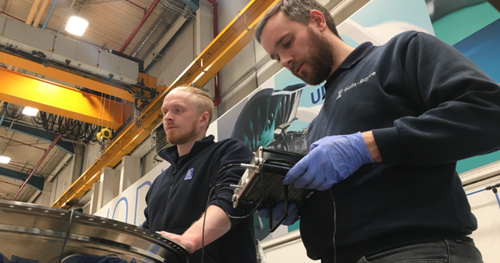Assembly of a critical bolted joint within a Rolls-Royce engine is currently reliable, but there were opportunities to improve and optimise the design for the fitter.
Future product designs are likely to require ever-increasing clamping load capability, driving the requirement for improved and more efficient methods. The bolted joint is located within a restricted and difficult-to-access geometry, severely limiting the options for in-situ measurement.

MTC identified the use of ultrasonic technology to enable in-situ measurement of bolt clamping load. It developed a functional tooling prototype to implement ultrasonic measurement capability within an existing tooling footprint. It designed and manufactured a suite of test hardware to prove the technology and the process. Then it conducted a detailed series of trials to prove performance, collect relevant parameters, and enable practical usage of technique on development engine build.
Outcomes include
- Creation of a bolt design ensuring correct ultrasonic functionality
- Development of a functional tooling prototype that enables ultrasonic measurement of bolt clamping load to within +/- 5kN
- Creation of representative ‘engine core’ test hardware that enables a full simulation of the bolted joint assembly process
- Test bench hardware that enables single-bolt testing for ongoing calibration
- Ongoing support to determine specific material and geometry factors for development engine bolt designs,
The solution, a functional tooling prototype that has been successfully used in assembly of engine demonstrator, is said to have significantly improved the accuracy of assembly clamping load measurement, enabling significant reduction in reserve factors. The system implemented involves a measurement system that directly displays bolt clamping load during operation and enables straightforward data collection for improved traceability. Its implementation within existing tooling means minimal impact to current assembly process. MTC also provided test hardware to enable demonstration of process, operator training, and future testing using new bolt materials, as well as measurement data and corresponding statistical analysis in order to support faster technology development/deployment.
“The combined Rolls-Royce and MTC team has produced an effective and efficient methodology which will provide many benefits to industry,” said Geraint Prisk, manufacturing engineering lead, UltraFan, Rolls Royce.










